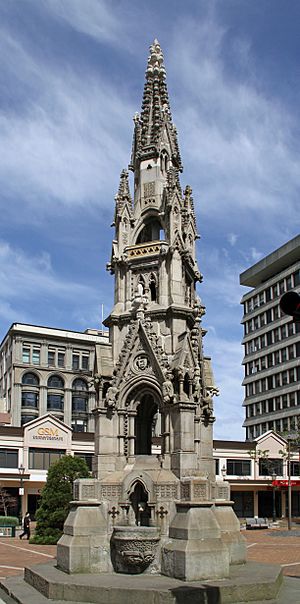Cargill Monument facts for kids
The Cargill Monument is a famous statue in central Dunedin, New Zealand. It honors Captain William Cargill, who helped found the city. The monument stands about 7.5 meters (25 feet) tall.
Contents
The Cargill Monument: A Dunedin Landmark
The Cargill Monument was designed by Charles Robert Swyer. It was built between 1863 and 1864. The monument is made from Tasmanian sandstone, resting on a base of local stone called phonolite.
What Does the Monument Look Like?
The monument's design is in the Gothic Revival style. This means it looks a bit like old churches or castles. It might have been inspired by the Scott Monument in Edinburgh, Scotland. You can see delicate carved patterns and interesting stone figures called grotesques on it. An architect named Nathaniel Wales once compared its design to England's Eleanor crosses. The monument also used to have drinking fountains, but they haven't worked for many years.
Where Has the Monument Been?
When it was first built, the monument stood in the very center of Dunedin, in a place called The Octagon. It even had railings around it. But in 1872, it was moved to its current spot in The Exchange. Today, you can find it on John Wickliffe Plaza, at the corner of Princes Street and Rattray Street.
A Special Historical Marker
At the bottom of the monument, there is a plaque. This plaque marks the spot where the first ever Salvation Army meeting in New Zealand took place. This important event happened in April 1883.
Protecting History
The Cargill Monument is very important to New Zealand's history. It is listed as a Category I heritage site by Heritage New Zealand. This means it is considered a place of special historical or cultural value.


